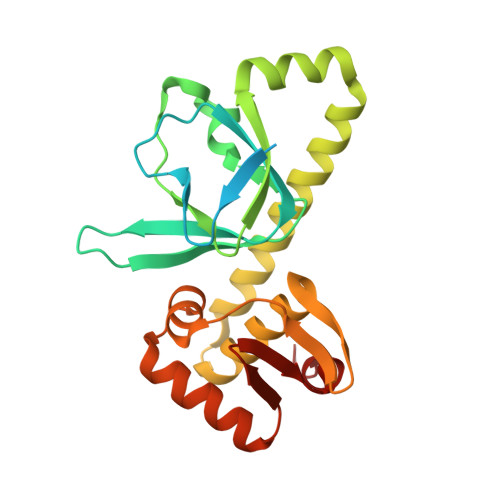Structural basis for the allosteric control of the global transcription factor NtcA by the nitrogen starvation signal 2-oxoglutarate.
Zhao, M.X., Jiang, Y.L., He, Y.X., Chen, Y.F., Teng, Y.B., Chen, Y.X., Zhang, C.C., Zhou, C.Z.(2010) Proc Natl Acad Sci U S A 107: 12487-12492
- PubMed: 20616047
- DOI: https://doi.org/10.1073/pnas.1001556107
- Primary Citation of Related Structures:
3LA2, 3LA3, 3LA7 - PubMed Abstract:
2-oxogluatarate (2-OG), a metabolite of the highly conserved Krebs cycle, not only plays a critical role in metabolism, but also constitutes a signaling molecule in a variety of organisms ranging from bacteria to plants and animals. In cyanobacteria, the accumulation of 2-OG constitutes the signal of nitrogen starvation and NtcA, a global transcription factor, has been proposed as a putative receptor for 2-OG. Here we present three crystal structures of NtcA from the cyanobacterium Anabaena: the apoform, and two ligand-bound forms in complex with either 2-OG or its analogue 2,2-difluoropentanedioic acid. All structures assemble as homodimers, with each subunit composed of an N-terminal effector-binding domain and a C-terminal DNA-binding domain connected by a long helix (C-helix). The 2-OG binds to the effector-binding domain at a pocket similar to that used by cAMP in catabolite activator protein, but with a different pattern. Comparative structural analysis reveals a putative signal transmission route upon 2-OG binding. A tighter coiled-coil conformation of the two C-helices induced by 2-OG is crucial to maintain the proper distance between the two F-helices for DNA recognition. Whereas catabolite activator protein adopts a transition from off-to-on state upon cAMP binding, our structural analysis explains well why NtcA can bind to DNA even in its apoform, and how 2-OG just enhances the DNA-binding activity of NtcA. These findings provided the structural insights into the function of a global transcription factor regulated by 2-OG, a metabolite standing at a crossroad between carbon and nitrogen metabolisms.
- Hefei National Laboratory for Physical Sciences at Microscale and School of Life Sciences, University of Science and Technology of China, Hefei, Anhui 230027, China.
Organizational Affiliation:

















